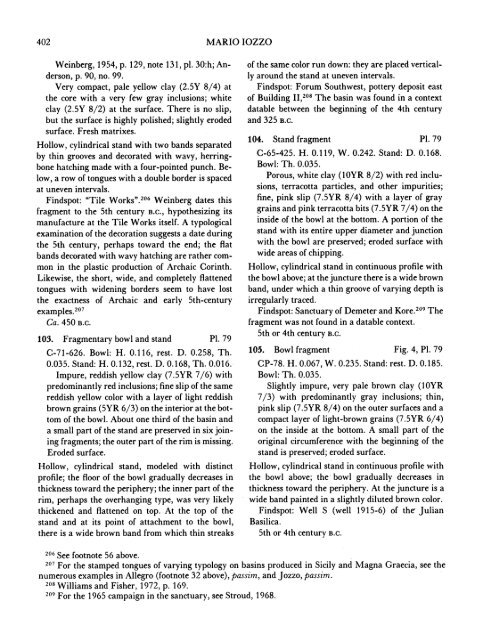f - The American School of Classical Studies at Athens
f - The American School of Classical Studies at Athens
f - The American School of Classical Studies at Athens
You also want an ePaper? Increase the reach of your titles
YUMPU automatically turns print PDFs into web optimized ePapers that Google loves.
402 MARIO IOZZO<br />
Weinberg, 1954, p. 129, note 131, pl. 30:h; An-<br />
derson, p. 90, no. 99.<br />
Very compact, pale yellow clay (2.5Y 8/4) <strong>at</strong><br />
the core with a very few gray inclusions; white<br />
clay (2.5Y 8/2) <strong>at</strong> the surface. <strong>The</strong>re is no slip,<br />
but the surface is highly polished; slightly eroded<br />
surface. Fresh m<strong>at</strong>rixes.<br />
Hollow, cylindrical stand with two bands separ<strong>at</strong>ed<br />
by thin grooves and decor<strong>at</strong>ed with wavy, herring-<br />
bone h<strong>at</strong>ching made with a four-pointed punch. Be-<br />
low, a row <strong>of</strong> tongues with a double border is spaced<br />
<strong>at</strong> uneven intervals.<br />
Findspot: "Tile Works".206 Weinberg d<strong>at</strong>es this<br />
fragment to the 5th century B.C., hypothesizing its<br />
manufacture <strong>at</strong> the Tile Works itself. A typological<br />
examin<strong>at</strong>ion <strong>of</strong> the decor<strong>at</strong>ion suggests a d<strong>at</strong>e during<br />
the 5th century, perhaps toward the end; the fl<strong>at</strong><br />
bands decor<strong>at</strong>ed with wavy h<strong>at</strong>ching are r<strong>at</strong>her com-<br />
mon in the plastic production <strong>of</strong> Archaic Corinth.<br />
Likewise, the short, wide, and completely fl<strong>at</strong>tened<br />
tongues with widening borders seem to have lost<br />
the exactness <strong>of</strong> Archaic and early 5th-century<br />
examples.207<br />
Ca. 450 B.C.<br />
103. Fragmentary bowl and stand P1. 79<br />
C-71-626. Bowl: H. 0.116, rest. D. 0.258, Th.<br />
0.035. Stand: H. 0.132, rest. D. 0.168, Th. 0.016.<br />
Impure, reddish yellow clay (7.5YR 7/6) with<br />
predominantly red inclusions; fine slip <strong>of</strong> the same<br />
reddish yellow color with a layer <strong>of</strong> light reddish<br />
brown grains (5YR 6/3) on the interior <strong>at</strong> the bot-<br />
tom <strong>of</strong> the bowl. About one third <strong>of</strong> the basin and<br />
a small part <strong>of</strong> the stand are preserved in six join-<br />
ing fragments; the outer part <strong>of</strong> the rim is missing.<br />
Eroded surface.<br />
Hollow, cylindrical stand, modeled with distinct<br />
pr<strong>of</strong>ile; the floor <strong>of</strong> the bowl gradually decreases in<br />
thickness toward the periphery; the inner part <strong>of</strong> the<br />
rim, perhaps the overhanging type, was very likely<br />
thickened and fl<strong>at</strong>tened on top. At the top <strong>of</strong> the<br />
stand and <strong>at</strong> its point <strong>of</strong> <strong>at</strong>tachment to the bowl,<br />
there is a wide brown band from which thin streaks<br />
<strong>of</strong> the same color run down: they are placed vertical-<br />
ly around the stand <strong>at</strong> uneven intervals.<br />
Findspot: Forum Southwest, pottery deposit east<br />
<strong>of</strong> Building 11,208 <strong>The</strong> basin was found in a context<br />
d<strong>at</strong>able between the beginning <strong>of</strong> the 4th century<br />
and 325 B.C.<br />
104. Stand fragment P1. 79<br />
C-65-425. H. 0.119, W. 0.242. Stand: D. 0.168.<br />
Bowl: Th. 0.035.<br />
Porous, white clay (IOYR 8/2) with red inclu-<br />
sions, terracotta particles, and other impurities;<br />
fine, pink slip (7.5YR 8/4) with a layer <strong>of</strong> gray<br />
grains and pink terracotta bits (7.5YR 7/4) on the<br />
inside <strong>of</strong> the bowl <strong>at</strong> the bottom. A portion <strong>of</strong> the<br />
stand with its entire upper diameter and junction<br />
with the bowl are preserved; eroded surface with<br />
wide areas <strong>of</strong> chipping.<br />
Hollow, cylindrical stand in continuous pr<strong>of</strong>ile with<br />
the bowl above; <strong>at</strong> the juncture there is a wide brown<br />
band, under which a thin groove <strong>of</strong> varying depth is<br />
irregularly traced.<br />
Findspot: Sanctuary <strong>of</strong> Demeter and Kore.209 <strong>The</strong><br />
fragment was not found in a d<strong>at</strong>able context.<br />
5th or 4th century B.C.<br />
105. Bowl fragment Fig. 4, P1. 79<br />
CP-78. H. 0.067, W. 0.235. Stand: rest. D. 0.185.<br />
Bowl: Th. 0.035.<br />
Slightly impure, very pale brown clay (1OYR<br />
7/3) with predominantly gray inclusions; thin,<br />
pink slip (7.5YR 8/4) on the outer surfaces and a<br />
compact layer <strong>of</strong> light-brown grains (7.5YR 6/4)<br />
on the inside <strong>at</strong> the bottom. A small part <strong>of</strong> the<br />
original circumference with the beginning <strong>of</strong> the<br />
stand is preserved; eroded surface.<br />
Hollow, cylindrical stand in continuous pr<strong>of</strong>ile with<br />
the bowl above; the bowl gradually decreases in<br />
thickness toward the periphery. At the juncture is a<br />
wide band painted in a slightly diluted brown color.<br />
Findspot: Well S (well 1915-6) <strong>of</strong> the Julian<br />
Basilica.<br />
5th or 4th century B.C.<br />
206 See footnote 56 above.<br />
207 For the stamped tongues <strong>of</strong> varying typology on basins produced in Sicily and Magna Graecia, see the<br />
numerous examples in Allegro (footnote 32 above), passim, and Jozzo, passim.<br />
208 Williams and Fisher, 1972, p. 169.<br />
209 For the 1965 campaign in the sanctuary, see Stroud, 1968.

















